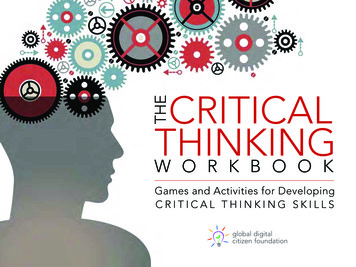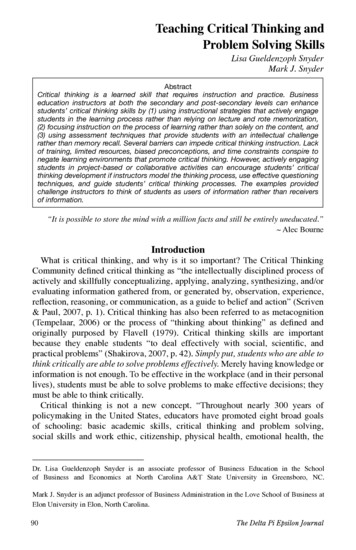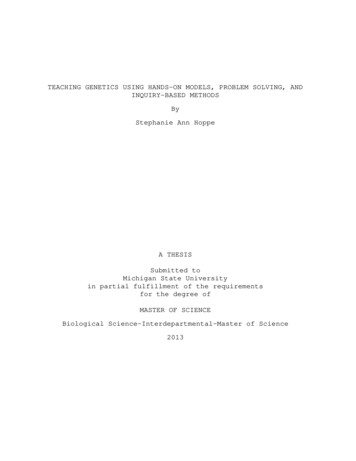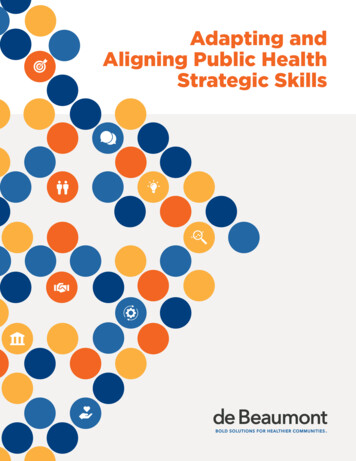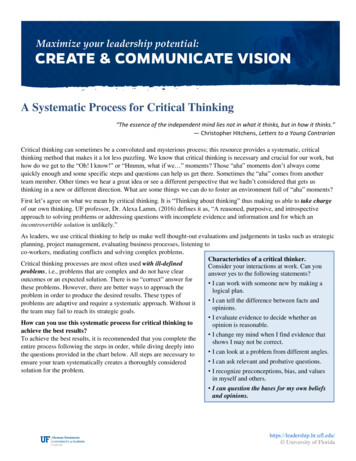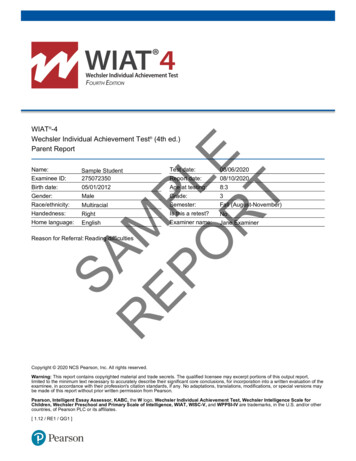
Transcription
Skills to Pay the BillsProblem Solving and Critical ThinkingEveryone experiences problems from time to time. Some of our problems are big and complicated, whileothers may be more easily solved. There is no shortage of challenges and issues that can arise on the job.Whether in an office or on a construction site, experiencing difficulties with the tasks at hand or with coworkers, the workplace presents ongoing challenges on a daily basis. Whether these problems are large orsmall, they need to be dealt with constructively and fairly. Having the necessary skills to identify solutions toproblems is one of the skills that employers look for in employees.Problem solving and critical thinking refers to the ability to useEmployers say they need a workforceknowledge, facts, and data to effectively solve problems. Thisfully equipped with skills beyond thedoesn’t mean you need to have an immediate answer, it meansbasics of reading, writing, and arithmeticyou have to be able to think on your feet, assess problems andfind solutions. The ability to develop a well thought out solutionto grow their businesses. These skillsinclude critical thinking and problemsolving, according to a 2010 Criticalwithin a reasonable time frame, however, is a skill thatSkills Survey by the Americanemployers value greatly.Management Association and others.Employers want employees who can work through problems on their own or as an effective member of ateam. Ideal employees can think critically and creatively, share thoughts and opinions, use good judgment,and make decisions. As a new employee, you may question why an organization follows certain steps tocomplete a task. It may seem to you that one of the steps could be eliminated saving time, effort, andmoney. But you may be hesitant to voice your opinion. Don’t be; employers are usually appreciative whennew employees are able to offer insight and fresh perspective into better and more efficient ways of doingthings. It is important to remember, however, that as someone new to the organization, you may not alwayshave the full picture, and thus there may be factors you are unaware of that dictate that things be done in aparticular way. Another important thing to remember is that when you are tasked with solving a problem, youdon’t always need to answer immediately.The activities in this section focus on learning how to solve problems in a variety of ways in the workplace.Participants will hear about how to properly tell the difference among criticism, praise, and feedback andreacting appropriately. The section will also review strategies for making ethical decisions, solving problemson a team with others, and learning how to take into account others’ perceptions when assessing actions orstatements in the workplace.A note to facilitators: Building self-determination skills, such as goal setting, decision-making, selfadvocacy, and problem solving should be included in career planning for all youth. Youth with disabilitiesand/or other (perceived) barriers to employment and/or disconnected youth will tend to have a resiliencynot always experienced by their same aged peers – and not always easily seen or understood by themselvesor by adults. You are encouraged to use the activities in this section to help young people explore how theobstacles they (or those they know) may face in life can pose an opportunity for developing anddemonstrating maturity, responsibility, and wisdom. Providing young people with safe opportunities toexplore how their personal resiliency can be used to develop enhanced problem solving and conflictresolutions skills is a opportunity many adults may shy away from, but one that may ultimately be a gift.98
Mastering Soft Skills for Workplace Success21. Praise, Criticism, or FeedbackJUST THE FACTS: In a work setting, we give and receive many different types of information. Thepurpose of this activity is to help participants determine the differences between criticism, praise, andfeedback – not only how to offer it, but how to receive it as well.Time20 minutesMaterials One set of “Praise Criticism Feedback” cards for each group. Alternatively, youmight choose to hang three pieces of chart paper – each with one of the words on it.Slips of paper could be made with the statements below.DirectionsDiscuss the difference between praise, criticism, and feedback and ask participants forexamples of each. Praise: an expression of approval Criticism: an expression of disapproval based on perceived mistakes or faults Feedback: information about a person’s performance of a task – used primarily as abasis for improvementDivide the group into pairs of two. Read the following statements aloud – one at a time. Itis suggested that the facilitator use different voice tones to truly help participantsdifferentiate the intended meaning of each sentence (which, by the way, can certainlyvary). After each statement, give each pair 10 seconds to decide whether the statement iscriticism, praise, or feedback. Someone from each team should hold up the card thatrepresents a collective decision. If chart paper and sentence strips were used, participantscould move around the room to match each statement to what they believe to be thecorrect match.1. Mr. Jones told me how much he appreciated your thank you note after the jobinterview. He thought it was a great personal touch.2. Your desk is such a mess. Are you sure you are not trying to grow your own paper?3. I noticed that you’ve been coming in late the last couple of days.4. How many times do I have to tell you how to file these documents?5. You look great today.6. It would work better for me if I could explain my version of the story out loud beforeyou ask questions.99
Skills to Pay the Bills7. You’ve improved a lot this week.8. I found it difficult to evaluate this resume because it was messy.9. I liked it much better when we got to choose the projects instead of being assigned to one.With the larger group, discuss the different ways people may react or respond differentlyto praise, criticism, and feedback. It is inevitable that we will all receive criticism at somepoint on the job, and the way in which we respond can impact our own attitude and theattitudes of those with whom we work. Discuss with the group how they, personally,respond differently to praise vs. feedback vs. criticism.ConclusionTake the opportunity to rephrase the way in which any of the above statements weremade. How might rephrasing get a different response or reaction? If you had to make arule for how you would like to receive feedback and criticism, what would that rule be?Journaling ActivityHow does it make you feel when others criticize the work you do? Are you able to respondto feedback differently? Think about a time when you criticized someone else. Whathappened? How did that situation ultimately make you feel?Extension ActivityOften times, the inability to give and/or receive criticism and feedback might causeconflict in the workplace. Reach out to the National Institute for Advanced ConflictResolution (http://www.niacr.org/pages/about.htm) to find local, no-cost trainingopportunities or workshops for participants. You might also try your state or county’smediation center (often connected to juvenile services) to see what programs are offered.100
Mastering Soft Skills for Workplace SuccessPRAISECRITICISMFEEDBACK101
Skills to Pay the Bills22. Workplace EthicsJUST THE FACTS: We all have our own set of values or standards of behavior that we operate by on adaily basis. However, we may not always feel we can apply these same principles or standards while atwork. The purpose of this lesson is to help participants learn some of the steps necessary to makeethical decisions on the job.Time30 minutesMaterials Activity 22 – one copy for each participant (or group). These materials were adaptedfrom Lesson Planet: Tools For Success: A Study in Employer/Personnel Issues, Ethics,and Professional Behavior (Alabama Learning Exchange)DirectionsAsk participants the following questions – and discuss answers with the group: How do youmake decisions? Is decision-making a skill that was taught to you? Do you have personalrules for decision-making? If you have rules, do these rules change if you are makingdecisions at home, at school, with friends, or at work?Now, let’s discuss ethics. What are ethics? [Possible answer to be discussed: a set of(often unspoken – and generally understood) moral principles relating to a specified group,field, or form of conduct; a group of moral principles, standards of behavior, or set ofvalues regarding proper conduct in the workplace].Ethics on the job often deal with a code of conduct or a set of principles for BOTH theemployer and the employee. Ask for and offer some examples of workplace ethics fromboth the EMPLOYER and the EMPLOYEE. For example:A list of work ethics for an employer or a company might be:102 To provide a safe work environment for staff and employees To treat employees with dignity and respect To provide a fair wage for the services rendered To handle all business transactions with integrity and honesty
Mastering Soft Skills for Workplace SuccessA list of work ethics for an employee might include: To show up on time To tend to company business for the whole time while at work To treat the company’s resources, equipment, and products with care To give respect to the company; that means honesty and integrityAsk the group what types of ethical issues might come up at work?Choose one of the scenarios in Activity 22 for group discussion (be sure to read theintroduction first). Read the scenario aloud (and have copies for those who would like toread it as well). With the group, walk through a basic process for ethical decision-making.Four-Step Process for Making Ethical Decisions at Work:1. Define the problem (or ethical situation).2. List the facts that appear to be most significant to the decision (and consider who isaffected).3. List two or three possible solutions (and how these solutions could impact each person).4. Decide on a plan of action.Divide the group into four smaller groups (and have each group choose one of theremaining scenarios). Each group should take no more than 10 minutes to read, discuss,and have a plan in place for discussion.ConclusionDo you think these situations really happen on the job – in real life? Share how thedecision-making process worked for each group. Were these easy problems to solve?Journaling ActivityWhen it comes to decision-making, there are some people who like to make decisions bythemselves, while others would like to talk things through with someone else. Which typeof person are you? Give an example or two. What are some of the pros and cons associatedwith each type of decision-maker?Extension ActivityHave the group create additional “case studies” to share with each other for problemsolving practice. Participants might ask an adult they know to offer a “real life” exampleof an ethical dilemma they have faced. These should be shared with the group.You might also consider expanding the discussion to include more examples of sexualharassment on the job. Unfortunately, this is not an uncommon issue for teens to bedealing with on the job.103
Skills to Pay the BillsActivity 22. Workplace Ethics: Case StudiesFor each of the following case studies, assume you are employed by a large computer company, withapproximately 1,000 employees. The company is located in your town. Read each case study andfollow the four steps for making ethical decisions. You will be discussing your decision-making process(and your ultimate decision) with the group.Case 1: LaKeisha is an administrative assistant in the Human Resources Department. Her good friendMichael is applying for a job with the company and has agreed to be a reference for him. Michael asksfor advice on preparing for the interview. LaKeisha has the actual interview questions asked of allapplicants and considers making him a copy of the list so he can prepare.Case 2: Emily works in the Quality Control Department. Once a year, her supervisor gives away thecompany’s used computers to the local elementary school. The company does not keep records ofthese computer donations. Emily really needs a computer. Her supervisor asks her to deliver 12computers to the school.Case 3: Marvin is an assistant in the Building Services Department. He has just received a new workcomputer and is excited to try it out. His supervisor has a strict policy about computer usage (forbusiness purposes only), but Marvin wants to learn the email software. He figures one good way to dothis is to send emails to his friends and relatives until he gets the hang of it. He has finished all of hiswork for the day and has 30 minutes left until his shift is over. His supervisor left early.Case 4: Jennie was recently hired to work as a receptionist for the front lobby. As receptionist, she isresponsible for making copies for the people in her office. Her son, Jason, comes in and needs somecopies for a school project. He brought his own paper and needs 300 copies for his class. If he doesn’tbring the copies with him, he will fail the project. The company copier does not require a security key,nor do they keep track of copies made by departments.Case 5: Nonye works in the Customer Service Support Department and spends a lot of his dayresponding to email. One day he got a message from an email address he didn’t recognize. It said,“I’d like to get to know you better, outside of work.” Nonye had no idea who sent it, so he deleted it.A few days later, he received another message from the same source. Nonye ignored the messageagain, thinking they would stop. He mentioned these emails to one of his co-workers, who responded,“You’re lucky to have a fan.” The messages continue to come every few days and he’s feeling prettyweirded out.104
Mastering Soft Skills for Workplace SuccessActivity 22. Continued - Steps to Solving Ethical DilemmasIdentify the problem or ethical issue:What are the facts?What are some possible solutions?What are you going to do?Also consider .how will you know if your decision was the right one?105
Skills to Pay the Bills23. Problem Solving on a TeamJUST THE FACTS: Working together to solve problems is not always easy. The purpose of this activityis to have participants explore how effective teams might address problems that occur among itsmembers.Time30 minutesMaterials Activity 23DirectionsThere are times when getting a team of people to work together successfully on a job or atschool can be a challenge. Occasionally one person might display a bad attitude (for onereason or another) and cause the team to be less than productive. Activity 23 presents 10different situations where the action of one team member is interfering with the team’ssuccess.Divide a large group into smaller groups. Have participants act out or create a skit foreach situation – providing both positive and negative alternatives for working through andsolving each problem. Participants should take turns being the “difficult” team member.Participants can compare skits and responses and, ultimately, decide (as a larger group) onthe best way(s) to handle each situation.ConclusionShould each person on the team be “dealt” with in the same way? Are there ever anyexceptions? Explain.Journaling ActivityThink about a time when you were on a team and one member of the team wasn’t contributing. How was the situation handled? What might you have done differently? If youare a team leader, what can you do to help all team members contribute?Extension ActivityUsing the problems listed in Activity 23, invite employers in to talk about how thesesituations are handled at their place of employment.106
Mastering Soft Skills for Workplace SuccessActivity 23. Problem Solving on a TeamIt’s hard work to keep a team working well together. What would you say to or do about a team memberin the following situations?1.Is always late.2.Whispers to others or starts side conversations during discussions.3.Gets upset when his/her recommendations are not followed.4.Hogs the conversation/discussion.5.Leaves before the job/work is done.6.Constantly tells jokes and gets people off track.7.Refuses to work with another “certain” team member.8.Won’t share in the leadership role.9.Falls asleep.10.Just sits there.107
Skills to Pay the Bills24. Perception vs. RealityJUST THE FACTS: Perception is one’s ability to see, hear, or become aware of something through oursenses. It is a way of understanding or interpreting something. Sometimes the way we perceive theactions or statements of those around us may or may not reflect what is actually intended. This isgenerally due to our previous life experiences and/or what we believe. The purpose of this activity is toget participants to reflect on and consider different perceptions and how to be proactive in makingdecisions based on those perceptions.Time15 minutesMaterials Activity 24 Optional: Flip chart and markersDirectionsWrite the following on a flip chart OR have one copy of the sentence for each participant:FINISHED FILES ARE THE RESULT OF YEARS OF SCIENTIFIC STUDY COMBINEDWITH THE EXPERIENCE OF YEARS.Ask the group to count the number of “Fs” in the sentence (allow 15 seconds). On average,most people will only spot three or four of the Fs in the sentence. There are actually six.(The brain tends to skip the word “of,” or perceive it as “versus”). Point: One’s perceptionmay not always be correct.Read the following short paragraphs aloud (or ask a youth participant to read):1.Bob’s daughter is on the basketball team, but she doesn’t get to play much. Hisdaughter works hard and never complains, but Bob believes this is yet anotherinjustice in his life and his daughter is not getting a fair shake. Bob becomesannoyed and irritated. He angrily confronts the coach, embarrassing his daughter.2.John’s daughter is on the basketball team, but she doesn’t get to play much. Hisdaughter works hard and never complains. John believes that the coach wants towin and most likely plays the girls that will help him reach that goal. John feelsproud of his daughter’s commitment to the team despite not getting to play verymuch. John offers to help his daughter improve her basketball skills.108
Mastering Soft Skills for Workplace SuccessIs there any difference in the events as they were described? What is the critical factor inthe different ways each person reacted? PERCEPTION! Bob believed the coach’s actionswere totally unfair – and John believed the coach was generally fair. Why might eachperson perceive the situation differently?Now, discuss the four situations listed in Activity 24. How might different people react tothese situations? What might their reactions be based on? If a friend found him or herselfin one of these situations, what advice would you offer?ConclusionAs a group, discuss some of the strategies you might use when faced with a situation similarto the ones in this activity. Is there always a right or wrong way to respond? Are therecertain things you should always try to do? If so, what are they?Journaling ActivityThink about how you perceive yourself and how others perceive you. Do you think both arethe same? Explain. What are some things you can you do to change others’ perception ofyou?Extension ActivityUse Google Images (or a similar search engine) to locate different posters or illustrations ofperception vs. reality. Print them out and offer reasoning as to why perceptions andrealities might not always be the same.109
Skills to Pay the BillsActivity 24 - Perception Vs. RealityWHAT WOULD YOU DO?1.Your boss is talking to another employee as you walk into work. You have reason to believe theyare talking about you. This makes you feel uncomfortable and upset.2.A close friend gets to go on a senior trip, all expenses paid. You are jealous that this friend doesnot have to pay a dime – his or her parents are paying for everything. You consider not goingbecause you have to pay for part of your trip and do not think it is fair.3.At work, you developed a new way to organize the filing system that makes it easier for theoffice staff to find documents. You think your supervisor is going to take all the credit.4.You are a nurse. The patient you are working with is ungrateful and rude, is always finding faultin everything you do, and is making your life miserable.110
Mastering Soft Skills for Workplace Success25. Tell Me About a Time When.JUST THE FACTS: Thinking on your feet is an important part of getting and keeping a job.Interviewers will often ask “behavioral” questions in addition to technical questions about actual jobskills. Often times, these open-ended questions will begin with, “Tell me about a time when .” Beingprepared for these types of questions – and having a plan for answering them – is an important skill.The purpose of this lesson is to introduce a strategy that participants can use to answer these types ofquestions calmly and effectively.Time30 minutesMaterials Activity 25 (one for each participant)DirectionsAsk participants the following questions:1. Who has been on a job interview?2. What types of questions were you asked?3. Were you ever asked questions that started with, “Tell me about a time when you ?”Discuss with participants that many of today’s employers ask certain types of questions to seehow well people can think on their feet. Sometimes these questions are easy to answer andother times, not so much. There is a strategy to use called STAR to help guide you throughthe process of answering these questions in a clear and complete way. Use the description onActivity 25 to describe this technique. Before asking participants to work on their ownanswers, use the following as an example of how the method works.Question: Tell me about a time when you provided customer service to an upset client.S - (Situation/Task)I was volunteering as an office assistant in the payroll department of a local nonprofitorganization. An angry employee came to my desk and explained that his check amount wastoo low and that he wasn’t able to pay rent on time because of the mistake.111
Skills to Pay the BillsA - (Action)I promised the man that I would work with him to figure out what happened and whatcould be done. I compared the payroll records logbook with the computer payroll database.I discovered a data error, which explained the incorrect amount. I explained whathappened and was able to put in a request to give the man a check for his missing balance.R - (Result)The employee thanked me and even asked to speak with my supervisor about how helpful Iwas.Offer participants the opportunity to work with one or a few peers. Encourage them topractice answering these questions and learning from each other. The more these types ofquestions are practiced, the easier they will be in an actual work or college interview.ConclusionWhat was the easiest part of this activity? What was the most difficult part of this activity?How might you practice the STAR technique? Do you think it would be worth practicing?Why or why not?Journaling ActivityPart of learning how to answer behavioral questions using the STAR method is recognizingyour own skills and the areas where you have improved. Do you feel comfortable talkingabout your skills? If yes, how did you reach this level of comfort? If no, how can you learnto develop this level of comfort?Extension ActivityArrange for participants to meet with a series of employers for mock interviews. Askemployers to use a sampling of the behavioral interview questions they use mostfrequently when interviewing potential candidates. Part of self-improvement is selfreflection. How can you use this activity to improve your soft skills overall?112
Mastering Soft Skills for Workplace SuccessActivity 25. Tell me About a Time When.Use the STAR strategy below to guide you in answering the sample interview questions, “Tell me abouta time when you ”Situation (or Task): Describe the situation that you were in or the task that needed to beaccomplished. Be specific and give enough detail so that the interviewer understands. The situationcould be from a previous job, a volunteer experience, school, or another relevant environment.Action you took: Describe the action you took. Be sure to keep the focus on you! Even if you’rediscussing a group project or effort, talk about what YOU did – not the efforts of the entire team.Don’t say what you might do or what you might have done. Say what you DID.Results you achieved: What happened? How did the event end? What did you accomplish? What didyou learn?TELL ME ABOUT A TIME WHEN YOU: did not agree with a teacher or supervisor? How did you handle the situation? were able to use persuasion to successfully convince someone to see things your way. were faced with a stressful situation that demonstrated your coping skills. used good judgment and logic to solve a problem. set a goal and were able to meet or achieve it. had to conform to a policy with which you did not agree. had too many things to do and were required to prioritize your tasks. were able to successfully deal with another person even when that individual may not havepersonally liked you (or vice versa). tried to accomplish something and failed. had to deal with a very upset customer or co-worker. you motivated others.113
These skills include critical thinking and problem solving, according to a 2010 Critical . 20 minutes . Materials. Directions Discuss the difference between praise, criticism, and feedback and ask participants for . Mastering Soft Skills for Workplace Success
